Hands 電子書籍 Hands-On [本・雑誌・コミック]
楽天市場検索
本・雑誌・コミック
小説・エッセイ (0)
資格・検定 (0)
ライフスタイル (0)
ホビー・スポーツ・美術 (0)
絵本・児童書・図鑑 (0)
語学・辞典・年鑑 (0)
学習参考書・問題集 (0)
旅行・留学 (0)
人文・地歴・社会 (0)
ビジネス・経済・就職 (0)
PC・システム開発 (2) (Hands 電子書籍 Hands-On)
科学・医学・技術 (0)
コミック (0)
ライトノベル (0)
ボーイズラブ (0)
ティーンズラブ (0)
エンターテインメント (0)
写真集 (0)
古書・希少本 (0)
楽譜 (0)
雑誌 (0)
新聞 (0)
洋書 (970) (Hands 電子書籍 Hands-On)
カレンダー (0)
ポスター (0)
パンフレット (0)
その他 (0)
本・雑誌・コミック
小説・エッセイ (0)
資格・検定 (0)
ライフスタイル (0)
ホビー・スポーツ・美術 (0)
絵本・児童書・図鑑 (0)
語学・辞典・年鑑 (0)
学習参考書・問題集 (0)
旅行・留学 (0)
人文・地歴・社会 (0)
ビジネス・経済・就職 (0)
PC・システム開発 (2) (Hands 電子書籍 Hands-On)
科学・医学・技術 (0)
コミック (0)
ライトノベル (0)
ボーイズラブ (0)
ティーンズラブ (0)
エンターテインメント (0)
写真集 (0)
古書・希少本 (0)
楽譜 (0)
雑誌 (0)
新聞 (0)
洋書 (970) (Hands 電子書籍 Hands-On)
カレンダー (0)
ポスター (0)
パンフレット (0)
その他 (0)
972件中 1件 - 30件
1 2 3 4 5 6
| 商品 | 説明 | 価格 |
|---|---|---|
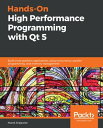 Hands-On High Performance Programming with Qt 5 Build cross-platform applications using concurrency, parallel programming, and memory management【電子書籍】[ Marek Krajewski ] 楽天Kobo電子書籍ストア | <p><strong>Build efficient and fast Qt applications, target performance problems, and discover solutions to refine your code</strong></p> <h4>Key Features</h4> <ul> <li>Build efficient and concurrent applications in Qt to create cross-platform applications</li> <li>Identify performance bottlenecks and apply the correct algorithm to improve application performance</li> <li>Delve into parallel programming and memory management to optimize your code</li> </ul> <h4>Book Description</h4> <p>Achieving efficient code through performance tuning is one of the key challenges faced by many programmers. This book looks at Qt programming from a performance perspective. You'll explore the performance problems encountered when using the Qt framework and means and ways to resolve them and optimize performance.</p> <p>The book highlights performance improvements and new features released in Qt 5.9, Qt 5.11, and 5.12 (LTE). You'll master general computer performance best practices and tools, which can help you identify the reasons behind low performance, and the most common performance pitfalls experienced when using the Qt framework. In the following chapters, you'll explore multithreading and asynchronous programming with C++ and Qt and learn the importance and efficient use of data structures. You'll also get the opportunity to work through techniques such as memory management and design guidelines, which are essential to improve application performance. Comprehensive sections that cover all these concepts will prepare you for gaining hands-on experience of some of Qt's most exciting application fields - the mobile and embedded development domains.</p> <p>By the end of this book, you'll be ready to build Qt applications that are more efficient, concurrent, and performance-oriented in nature</p> <h4>What you will learn</h4> <ul> <li>Understand classic performance best practices</li> <li>Get to grips with modern hardware architecture and its performance impact</li> <li>Implement tools and procedures used in performance optimization</li> <li>Grasp Qt-specific work techniques for graphical user interface (GUI) and platform programming</li> <li>Make Transmission Control Protocol (TCP) and Hypertext Transfer Protocol (HTTP) performant and use the relevant Qt classes</li> <li>Discover the improvements Qt 5.9 (and the upcoming versions) holds in store</li> <li>Explore Qt's graphic engine architecture, strengths, and weaknesses</li> </ul> <h4>Who this book is for</h4> <p>This book is designed for Qt developers who wish to build highly performance applications for desktop and embedded devices. Programming Experience with C++ is required.</p>画面が切り替わりますので、しばらくお待ち下さい。 ※ご購入は、楽天kobo商品ページからお願いします。※切り替わらない場合は、こちら をクリックして下さい。 ※このページからは注文できません。 | 3,858円 |
 Hands-On Value-at-Risk and Expected Shortfall A Practical Primer【電子書籍】[ Martin Auer ] 楽天Kobo電子書籍ストア | <p>This book describes a maximally simple market risk model that is still practical and main risk measures like the value-at-risk and the expected shortfall. It outlines the model's (i) underlying math, (ii) daily operation, and (iii) implementation, while stripping away statistical overhead to keep the concepts accessible. The author selects and weighs the various model features, motivating the choices under real-world constraints, and addresses the evermore important handling of regulatory requirements. The book targets not only practitioners new to the field but also experienced market risk operators by suggesting useful data analysis procedures and implementation details. It furthermore addresses market risk consumers such as managers, traders, and compliance officers by making the model behavior intuitively transparent.</p> <p><em>A very useful guide to the theoretical and practical aspects of implementing and operating a risk-monitoring system for a mid-size financial institution. It sets a common body of knowledge to facilitate communication between risk managers, computer and investment specialists by bridging their diverse backgrounds.</em></p> <p><strong>Giovanni Barone-Adesi</strong> ー Professor, Universit? della Svizzera italiana</p> <p><em>This unassuming and insightful book starts from the basics and plainly brings the reader up to speed on both theory and implementation.</em></p> <p><strong>Shane Hegarty</strong> ー Director Trade Floor Risk Management, Scotiabank</p> <p>Visit the book’s website at www.value-at-risk.com.</p>画面が切り替わりますので、しばらくお待ち下さい。 ※ご購入は、楽天kobo商品ページからお願いします。※切り替わらない場合は、こちら をクリックして下さい。 ※このページからは注文できません。 | 6,928円 |
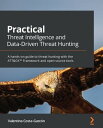 Practical Threat Intelligence and Data-Driven Threat Hunting A hands-on guide to threat hunting with the ATT&CK? Framework and open source tools【電子書籍】[ Valentina Costa-Gazcon ] 楽天Kobo電子書籍ストア | <p><strong>Get to grips with cyber threat intelligence and data-driven threat hunting while exploring expert tips and techniques</strong></p> <h4>Key Features</h4> <ul> <li>Set up an environment to centralize all data in an Elasticsearch, Logstash, and Kibana (ELK) server that enables threat hunting</li> <li>Carry out atomic hunts to start the threat hunting process and understand the environment</li> <li>Perform advanced hunting using MITRE ATT&CK Evals emulations and Mordor datasets</li> </ul> <h4>Book Description</h4> <p>Threat hunting (TH) provides cybersecurity analysts and enterprises with the opportunity to proactively defend themselves by getting ahead of threats before they can cause major damage to their business.</p> <p>This book is not only an introduction for those who don't know much about the cyber threat intelligence (CTI) and TH world, but also a guide for those with more advanced knowledge of other cybersecurity fields who are looking to implement a TH program from scratch.</p> <p>You will start by exploring what threat intelligence is and how it can be used to detect and prevent cyber threats. As you progress, you'll learn how to collect data, along with understanding it by developing data models. The book will also show you how to set up an environment for TH using open source tools. Later, you will focus on how to plan a hunt with practical examples, before going on to explore the MITRE ATT&CK framework.</p> <p>By the end of this book, you'll have the skills you need to be able to carry out effective hunts in your own environment.</p> <h4>What you will learn</h4> <ul> <li>Understand what CTI is, its key concepts, and how it is useful for preventing threats and protecting your organization</li> <li>Explore the different stages of the TH process</li> <li>Model the data collected and understand how to document the findings</li> <li>Simulate threat actor activity in a lab environment</li> <li>Use the information collected to detect breaches and validate the results of your queries</li> <li>Use documentation and strategies to communicate processes to senior management and the wider business</li> </ul> <h4>Who this book is for</h4> <p>If you are looking to start out in the cyber intelligence and threat hunting domains and want to know more about how to implement a threat hunting division with open-source tools, then this cyber threat intelligence book is for you.</p>画面が切り替わりますので、しばらくお待ち下さい。 ※ご購入は、楽天kobo商品ページからお願いします。※切り替わらない場合は、こちら をクリックして下さい。 ※このページからは注文できません。 | 4,085円 |
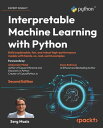 Interpretable Machine Learning with Python Build explainable, fair, and robust high-performance models with hands-on, real-world examples【電子書籍】[ Serg Mas?s ] 楽天Kobo電子書籍ストア | <p><b>A deep dive into the key aspects and challenges of machine learning interpretability using a comprehensive toolkit, including SHAP, feature importance, and causal inference, to build fairer, safer, and more reliable models. Purchase of the print or Kindle book includes a free eBook in PDF format.</b></p><h2>Key Features</h2><ul><li>Interpret real-world data, including cardiovascular disease data and the COMPAS recidivism scores</li><li>Build your interpretability toolkit with global, local, model-agnostic, and model-specific methods</li><li>Analyze and extract insights from complex models from CNNs to BERT to time series models</li></ul><h2>Book Description</h2>Interpretable Machine Learning with Python, Second Edition, brings to light the key concepts of interpreting machine learning models by analyzing real-world data, providing you with a wide range of skills and tools to decipher the results of even the most complex models. Build your interpretability toolkit with several use cases, from flight delay prediction to waste classification to COMPAS risk assessment scores. This book is full of useful techniques, introducing them to the right use case. Learn traditional methods, such as feature importance and partial dependence plots to integrated gradients for NLP interpretations and gradient-based attribution methods, such as saliency maps. In addition to the step-by-step code, you’ll get hands-on with tuning models and training data for interpretability by reducing complexity, mitigating bias, placing guardrails, and enhancing reliability. By the end of the book, you’ll be confident in tackling interpretability challenges with black-box models using tabular, language, image, and time series data.<h2>What you will learn</h2><ul><li>Progress from basic to advanced techniques, such as causal inference and quantifying uncertainty</li><li>Build your skillset from analyzing linear and logistic models to complex ones, such as CatBoost, CNNs, and NLP transformers</li><li>Use monotonic and interaction constraints to make fairer and safer models</li><li>Understand how to mitigate the influence of bias in datasets</li><li>Leverage sensitivity analysis factor prioritization and factor fixing for any model</li><li>Discover how to make models more reliable with adversarial robustness</li></ul><h2>Who this book is for</h2><p>This book is for data scientists, machine learning developers, machine learning engineers, MLOps engineers, and data stewards who have an increasingly critical responsibility to explain how the artificial intelligence systems they develop work, their impact on decision making, and how they identify and manage bias. It’s also a useful resource for self-taught ML enthusiasts and beginners who want to go deeper into the subject matter, though a good grasp of the Python programming language is needed to implement the examples.</p>画面が切り替わりますので、しばらくお待ち下さい。 ※ご購入は、楽天kobo商品ページからお願いします。※切り替わらない場合は、こちら をクリックして下さい。 ※このページからは注文できません。 | 4,304円 |
 Hands-on Intermediate Econometrics Using R Templates for Learning Quantitative Methods and R Software【電子書籍】[ Hrishikesh D Vinod ] 楽天Kobo電子書籍ストア | <p>How to learn both applied statistics (econometrics) and free, open-source software R? This book allows students to have a sense of accomplishment by copying and pasting many hands-on templates provided here.</p> <p>The textbook is essential for anyone wishing to have a practical understanding of an extensive range of topics in Econometrics. No other text provides software snippets to learn so many new statistical tools with hands-on examples. The explicit knowledge of inputs and outputs of each new method allows the student to know which algorithm is worth studying. The book offers sufficient theoretical and algorithmic details about a vast range of statistical techniques.</p> <p>The second edition's preface lists the following topics generally absent in other textbooks. (i) Iteratively reweighted least squares, (ii) Pillar charts to represent 3D data. (iii) Stochastic frontier analysis (SFA) (iv) model selection with Mallows' Cp criterion. (v) Hodrick-Prescott (HP) filter. (vi) Automatic ARIMA models. (vi) Nonlinear Granger-causality using kernel regressions and bootstrap confidence intervals. (vii) new Keynesian Phillips curve (NKPC). (viii) Market-neutral pairs trading using two cointegrated stocks. (ix) Artificial neural network (ANN) for product-specific forecasting. (x) Vector AR and VARMA models. (xi) New tools for diagnosing the endogeneity problem. (xii) The elegant set-up of k-class estimators and identification. (xiii) Probit-logit models and Heckman selection bias correction. (xiv) Receiver operating characteristic (ROC) curves and areas under them. (xv) Confusion matrix. (xvi) Quantile regression (xvii) Elastic net estimator. (xviii) generalized Correlations (xix) maximum entropy bootstrap for time series. (xx) Convergence concepts quantified. (xxi) Generalized partial correlation coefficients (xxii) Panel data and duration (survival) models.</p> <p><strong>Contents:</strong></p> <ul> <li>Production Function and Regression Methods Using R</li> <li>Univariate Time Series Analysis with R</li> <li>Bivariate Time Series Analysis Including Stochastic Diffusion and Cointegration</li> <li>Utility Theory and Empirical Implications</li> <li>Vector Models for Multivariate Problems</li> <li>Simultaneous Equation Models</li> <li>Limited Dependent Variable (GLM) Models</li> <li>Consumption and Demand: Kernel Regressions and Machine Learning</li> <li>Single, Double, and Maximum Entropy Bootstrap and Inference</li> <li>Generalized Least Squares, VARMA, and Estimating Functions</li> <li>Box?Cox, Loess, Projection Pursuit, Quantile and Threshold Regression</li> <li>Miscellany: Dependence, Correlations, Information Entropy, Causality, Panel Data, and Exact Stochastic Dominance</li> </ul> <p><strong>Readership:</strong> Undergraduate and graduate students of economics and econometrics, applied statisticians and finance professionals.<br /> <strong>Key Features:</strong></p> <ul> <li>Uniquely comprehensive coverage, including many very recently developed topics</li> <li>Includes software snippets (that help learn the R language) for readers who are not interested in economics examples</li> </ul>画面が切り替わりますので、しばらくお待ち下さい。 ※ご購入は、楽天kobo商品ページからお願いします。※切り替わらない場合は、こちら をクリックして下さい。 ※このページからは注文できません。 | 7,037円 |
 Hands-On Unity 2021 Game Development Create, customize, and optimize your own professional games from scratch with Unity 2021, 2nd Edition【電子書籍】[ Nicolas Alejandro Borromeo ] 楽天Kobo電子書籍ストア | <p><strong>Achieve mesmerizing game experiences using the latest Unity 2021 features by following a practical approach to building professional games</strong></p> <h4>Key Features</h4> <ul> <li>Unleash the capabilities of C# scripting to create UIs, graphics, game AI agents and more</li> <li>Explore Unity's latest tools, including Universal Render Pipeline, Shader Graph, UI Toolkit, Visual Scripting, and VFX graph, to enhance graphics and animation</li> <li>Build an AR experience using Unity's AR Foundation</li> </ul> <h4>Book Description</h4> <p>Learning how to use Unity is the quickest way to creating a full game, but that's not all you can do with this simple, yet comprehensive suite of video game development tools ? Unity is just as useful for creating AR/VR experiences, complex simulations, real-time realistic rendering, films, and practical games for training and education.</p> <p>Hands-On Unity 2021 Game Development outlines a practical journey to creating your first full game from the ground up, building it step-by-step and applying your knowledge as you progress.</p> <p>Complete with hands-on tutorials and projects, this easy-to-follow guide will teach you how to develop the game using several Unity tools. As you advance, you will learn how to use the Unity engine, create simple scripts using C#, integrate graphics, sound, and animations, and manipulate physics to create interesting mechanics for your game. You'll be able to apply all the knowledge that you gain to a real-world game.</p> <p>Later chapters will show you how to code a simple AI agent to challenge the user and use profiling tools to ensure that the code runs efficiently. Finally, you'll work with Unity's AR tools to create AR experiences for 3D apps and games.</p> <p>By the end of this Unity book, you will have created a complete game and built a solid foundation in using a wide variety of Unity tools.</p> <h4>What you will learn</h4> <ul> <li>Explore both C# and Visual Scripting tools to customize various aspects of a game, such as physics, gameplay, and the UI</li> <li>Program rich shaders and effects using Unity's new Shader Graph and Universal Render Pipeline</li> <li>Implement postprocessing to improve graphics quality with full-screen effects</li> <li>Create rich particle systems for your Unity games from scratch using VFX Graph and Shuriken</li> <li>Add animations to your game using the Animator, Cinemachine, and Timeline</li> <li>Use the brand new UI Toolkit package to create user interfaces</li> <li>Implement game AI to control character behavior</li> </ul> <h4>Who this book is for</h4> <p>This book is best suited for game developers looking to upgrade their knowledge and those who want to migrate their existing skills to the Unity game engine. Those with prior Unity knowledge will also benefit from the chapters exploring the latest features. While you'll still able to follow along if you don't have any programming experience, knowing the fundamentals of C# programming will help you get the most out of this book.</p>画面が切り替わりますので、しばらくお待ち下さい。 ※ご購入は、楽天kobo商品ページからお願いします。※切り替わらない場合は、こちら をクリックして下さい。 ※このページからは注文できません。 | 3,858円 |
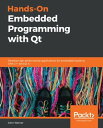 Hands-On Embedded Programming with Qt Develop high performance applications for embedded systems with C++ and Qt 5【電子書籍】[ John Werner ] 楽天Kobo電子書籍ストア | <p><strong>A comprehensive guide that will get you up and running with embedded software development using Qt5</strong></p> <h4>Key Features</h4> <ul> <li>Learn to create fluid, cross-platform applications for embedded devices</li> <li>Achieve optimum performance in your applications with QT Lite project</li> <li>Explore the implementation of Qt with IoT using QtMqtt, QtKNX, and QtWebSockets</li> </ul> <h4>Book Description</h4> <p>Qt is an open-source toolkit suitable for cross-platform and embedded application development. This book uses inductive teaching to help you learn how to create applications for embedded and Internet of Things (IoT) devices with Qt 5.</p> <p>You'll start by learning to develop your very first application with Qt. Next, you'll build on the first application by understanding new concepts through hands-on projects and written text. Each project will introduce new features that will help you transform your basic first project into a connected IoT application running on embedded hardware. In addition to practical experience in developing an embedded Qt project, you will also gain valuable insights into best practices for Qt development, along with exploring advanced techniques for testing, debugging, and monitoring the performance of Qt applications. Through the course of the book, the examples and projects are demonstrated in a way so that they can be run both locally and on an embedded platform.</p> <p>By the end of this book, you will have the skills you need to use Qt 5 to confidently develop modern embedded applications.</p> <h4>What you will learn</h4> <ul> <li>Understand how to develop Qt applications using Qt Creator under Linux</li> <li>Explore various Qt GUI technologies to build resourceful and interactive applications</li> <li>Understand Qt's threading model to maintain a responsive UI</li> <li>Get to grips with remote target load and debug under Qt Creator</li> <li>Become adept at writing IoT code using Qt</li> <li>Learn a variety of software best practices to ensure that your code is efficient</li> </ul> <h4>Who this book is for</h4> <p>This book is for software and hardware professionals with experience in different domains who are seeking new career opportunities in embedded systems and IoT. Working knowledge of the C++ Linux command line will be useful to get the most out of this book.</p>画面が切り替わりますので、しばらくお待ち下さい。 ※ご購入は、楽天kobo商品ページからお願いします。※切り替わらない場合は、こちら をクリックして下さい。 ※このページからは注文できません。 | 3,290円 |
 Infrastructure-as-Code Automation Using Terraform, Packer, Vault, Nomad and Consul Hands-on Deployment, Configuration, and Best Practices【電子書籍】[ Navin Sabharwal ] 楽天Kobo電子書籍ストア | <p>Discover the methodologies and best practices for getting started with HashiCorp tools, including Terraform, Vault, and Packer. The book begins with an introduction to the infrastructure-as-code concept while establishing the need for automation and management technologies. You’ll go over hands-on deployment, configuration, and best practices for Terraform, Packer, Vault, Nomad, and Consul. You’ll then delve deeper into developing automation code using Terraform for automating AWS/Azure/GCP public cloud tasks; advanced topics include leveraging Vault for secrets management and Packer for image management.</p> <p>Along the way you will also look at Nomad and Consul for managing application orchestration along with network interconnectivity. In each chapter you will cover automated infrastructure and application deployment on the VM/container base ecosystem. The book provides sample code and best-practice guidance for developers and architects to look at infrastructure-as-code adoptionfrom a holistic viewpoint.</p> <p>All the code presented in the book is available in the form of scripts, which allow you to try out the examples and extend them in interesting ways.</p> <p><strong>What You Will Learn</strong></p> <ul> <li>Get an overview of the architecture of Terraform, Vault, Packer, Nomad, and Consul</li> <li>Follow hands-on steps for enabling Terraform, Vault, Packer, Nomad, and Consul</li> <li>Automate various services on the public cloud, including AWS, Azure, and GCP</li> </ul> <p><strong>Who This Book Is For</strong></p> <p>Developers, architects, and administrators who want to learn about infrastructure-as-code automation.</p>画面が切り替わりますので、しばらくお待ち下さい。 ※ご購入は、楽天kobo商品ページからお願いします。※切り替わらない場合は、こちら をクリックして下さい。 ※このページからは注文できません。 | 6,685円 |
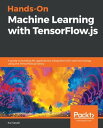 Hands-On Machine Learning with TensorFlow.js A guide to building ML applications integrated with web technology using the TensorFlow.js library【電子書籍】[ Kai Sasaki ] 楽天Kobo電子書籍ストア | <p><strong>Get hands-on with the browser-based JavaScript library for training and deploying machine learning models effectively</strong></p> <h4>Key Features</h4> <ul> <li>Build, train and run machine learning models in the browser using TensorFlow.js</li> <li>Create smart web applications from scratch with the help of useful examples</li> <li>Use flexible and intuitive APIs from TensorFlow.js to understand how machine learning algorithms function</li> </ul> <h4>Book Description</h4> <p>TensorFlow.js is a framework that enables you to create performant machine learning (ML) applications that run smoothly in a web browser. With this book, you will learn how to use TensorFlow.js to implement various ML models through an example-based approach.</p> <p>Starting with the basics, you'll understand how ML models can be built on the web. Moving on, you will get to grips with the TensorFlow.js ecosystem to develop applications more efficiently. The book will then guide you through implementing ML techniques and algorithms such as regression, clustering, fast Fourier transform (FFT), and dimensionality reduction. You will later cover the Bellman equation to solve Markov decision process (MDP) problems and understand how it is related to reinforcement learning. Finally, you will explore techniques for deploying ML-based web applications and training models with TensorFlow Core. Throughout this ML book, you'll discover useful tips and tricks that will build on your knowledge.</p> <p>By the end of this book, you will be equipped with the skills you need to create your own web-based ML applications and fine-tune models to achieve high performance.</p> <h4>What you will learn</h4> <ul> <li>Use the t-SNE algorithm in TensorFlow.js to reduce dimensions in an input dataset</li> <li>Deploy tfjs-converter to convert Keras models and load them into TensorFlow.js</li> <li>Apply the Bellman equation to solve MDP problems</li> <li>Use the k-means algorithm in TensorFlow.js to visualize prediction results</li> <li>Create tf.js packages with Parcel, Webpack, and Rollup to deploy web apps</li> <li>Implement tf.js backend frameworks to tune and accelerate app performance</li> </ul> <h4>Who this book is for</h4> <p>This book is for web developers who want to learn how to integrate machine learning techniques with web-based applications from scratch. This book will also appeal to data scientists, machine learning practitioners, and deep learning enthusiasts who are looking to perform accelerated, browser-based machine learning on Web using TensorFlow.js. Working knowledge of JavaScript programming language is all you need to get started.</p>画面が切り替わりますので、しばらくお待ち下さい。 ※ご購入は、楽天kobo商品ページからお願いします。※切り替わらない場合は、こちら をクリックして下さい。 ※このページからは注文できません。 | 3,858円 |
 Hands-On Genetic Algorithms with Python Applying genetic algorithms to solve real-world deep learning and artificial intelligence problems【電子書籍】[ Eyal Wirsansky ] 楽天Kobo電子書籍ストア | <p><strong>Explore the ever-growing world of genetic algorithms to solve search, optimization, and AI-related tasks, and improve machine learning models using Python libraries such as DEAP, scikit-learn, and NumPy</strong></p> <h4>Key Features</h4> <ul> <li>Explore the ins and outs of genetic algorithms with this fast-paced guide</li> <li>Implement tasks such as feature selection, search optimization, and cluster analysis using Python</li> <li>Solve combinatorial problems, optimize functions, and enhance the performance of artificial intelligence applications</li> </ul> <h4>Book Description</h4> <p>Genetic algorithms are a family of search, optimization, and learning algorithms inspired by the principles of natural evolution. By imitating the evolutionary process, genetic algorithms can overcome hurdles encountered in traditional search algorithms and provide high-quality solutions for a variety of problems. This book will help you get to grips with a powerful yet simple approach to applying genetic algorithms to a wide range of tasks using Python, covering the latest developments in artificial intelligence.</p> <p>After introducing you to genetic algorithms and their principles of operation, you'll understand how they differ from traditional algorithms and what types of problems they can solve. You'll then discover how they can be applied to search and optimization problems, such as planning, scheduling, gaming, and analytics. As you advance, you'll also learn how to use genetic algorithms to improve your machine learning and deep learning models, solve reinforcement learning tasks, and perform image reconstruction. Finally, you'll cover several related technologies that can open up new possibilities for future applications.</p> <p>By the end of this book, you'll have hands-on experience of applying genetic algorithms in artificial intelligence as well as in numerous other domains.</p> <h4>What you will learn</h4> <ul> <li>Understand how to use state-of-the-art Python tools to create genetic algorithm-based applications</li> <li>Use genetic algorithms to optimize functions and solve planning and scheduling problems</li> <li>Enhance the performance of machine learning models and optimize deep learning network architecture</li> <li>Apply genetic algorithms to reinforcement learning tasks using OpenAI Gym</li> <li>Explore how images can be reconstructed using a set of semi-transparent shapes</li> <li>Discover other bio-inspired techniques, such as genetic programming and particle swarm optimization</li> </ul> <h4>Who this book is for</h4> <p>This book is for software developers, data scientists, and AI enthusiasts who want to use genetic algorithms to carry out intelligent tasks in their applications. Working knowledge of Python and basic knowledge of mathematics and computer science will help you get the most out of this book.</p>画面が切り替わりますので、しばらくお待ち下さい。 ※ご購入は、楽天kobo商品ページからお願いします。※切り替わらない場合は、こちら をクリックして下さい。 ※このページからは注文できません。 | 3,290円 |
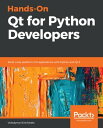 Hands-on Qt for Python Developers【電子書籍】[ Volodymyr Kirichinets ] 楽天Kobo電子書籍ストア | <ol> <li>Python, Qt and C++ with examples.</li> <li>QML and Qt Quick with examples.</li> <li>PyQt and PySide with examples.</li> <li>Graphics, Graphical Effects and multimedia.</li> <li>Working with Databases (SQL, NoSQL).</li> <li>Signals, slots, and event handlers with examples.</li> <li>Threading and Multiprocessing in examples of large scale constructions.</li> </ol>画面が切り替わりますので、しばらくお待ち下さい。 ※ご購入は、楽天kobo商品ページからお願いします。※切り替わらない場合は、こちら をクリックして下さい。 ※このページからは注文できません。 | 935円 |
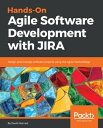 Hands-On Agile Software Development with JIRA Design and manage software projects using the Agile methodology【電子書籍】[ David Harned ] 楽天Kobo電子書籍ストア | <p><strong>Plan, track, and release great software</strong></p> <h4>Key Features</h4> <ul> <li>Learn to create reports and dashboard for effective project management</li> <li>Implement your development strategy in JIRA.</li> <li>Practices to help you manage the issues in the development team</li> </ul> <h4>Book Description</h4> <p>As teams scale in size, project management can get very complicated. One of the best tools to deal with this kind of problem is JIRA.</p> <p>This book will start by organizing your project requirements and the principles of Agile development to get you started. You will then be introduced to set up a JIRA account and the JIRA ecosystem to help you implement a dashboard for your team's work and issues. You will learn how to manage any issues and bugs that might emerge in the development stage. Going ahead, the book will help you build reports and use them to plan the releases based on the study of the reports. Towards the end, you will come across working with the gathered data and create a dashboard that helps you track the project's development.</p> <h4>What you will learn</h4> <ul> <li>Create your first project (and manage existing projects) in JIRA</li> <li>Manage your board view and backlogs in JIRA</li> <li>Run a Scrum Sprint project in JIRA</li> <li>Create reports (including topic-based reports)</li> <li>Forecast using versions</li> <li>Search for issues with JIRA Query Language (JQL)</li> <li>Execute bulk changes to issues</li> <li>Create custom filters, dashboards, and widgets</li> <li>Create epics, stories, bugs, and tasks</li> </ul> <h4>Who this book is for</h4> <p>This book is for administrators who wants to apply the Agile approach to managing the issues, bugs, and releases in their software development projects using JIRA.</p>画面が切り替わりますので、しばらくお待ち下さい。 ※ご購入は、楽天kobo商品ページからお願いします。※切り替わらない場合は、こちら をクリックして下さい。 ※このページからは注文できません。 | 2,723円 |
 Python Crash Course, 2nd Edition A Hands-On, Project-Based Introduction to Programming【電子書籍】[ Eric Matthes ] 楽天Kobo電子書籍ストア | <p>**The best-selling Python book in the world, with over 1 million copies sold!</p> <p>A fast-paced, no-nonsense, updated guide to programming in Python.**</p> <p>If you've been thinking about learning how to code or picking up Python, this internationally bestselling guide to the most popular programming language is your quickest, easiest way to get started and go! Even if you have no experience whatsoever, <em>Python Crash Course, 2nd Edition</em>, will have you writing programs, solving problems, building computer games, and creating data visualizations in no time.</p> <p>You’ll begin with basic concepts like variables, lists, classes, and loopsーwith the help of fun skill-strengthening exercises for every topicーthen move on to making interactive programs and best practices for testing your code. Later chapters put your new knowledge into play with three cool projects: a 2D Space Invaders-style arcade game, a set of responsive data visualizations you’ll build with Python's handy libraries (Pygame, Matplotlib, Plotly, Django), and a customized web app you can deploy online.</p> <p>Why wait any longer? Start your engine and code!</p>画面が切り替わりますので、しばらくお待ち下さい。 ※ご購入は、楽天kobo商品ページからお願いします。※切り替わらない場合は、こちら をクリックして下さい。 ※このページからは注文できません。 | 3,414円 |
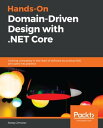 Hands-On Domain-Driven Design with .NET Core Tackling complexity in the heart of software by putting DDD principles into practice【電子書籍】[ Alexey Zimarev ] 楽天Kobo電子書籍ストア | <p><strong>Solve complex business problems by understanding users better, finding the right problem to solve, and building lean event-driven systems to give your customers what they really want</strong></p> <h4>Key Features</h4> <ul> <li>Apply DDD principles using modern tools such as EventStorming, Event Sourcing, and CQRS</li> <li>Learn how DDD applies directly to various architectural styles such as REST, reactive systems, and microservices</li> <li>Empower teams to work flexibly with improved services and decoupled interactions</li> </ul> <h4>Book Description</h4> <p>Developers across the world are rapidly adopting DDD principles to deliver powerful results when writing software that deals with complex business requirements. This book will guide you in involving business stakeholders when choosing the software you are planning to build for them. By figuring out the temporal nature of behavior-driven domain models, you will be able to build leaner, more agile, and modular systems.</p> <p>You'll begin by uncovering domain complexity and learn how to capture the behavioral aspects of the domain language. You will then learn about EventStorming and advance to creating a new project in .NET Core 2.1; you'll also and write some code to transfer your events from sticky notes to C#. The book will show you how to use aggregates to handle commands and produce events. As you progress, you'll get to grips with Bounded Contexts, Context Map, Event Sourcing, and CQRS. After translating domain models into executable C# code, you will create a frontend for your application using Vue.js. In addition to this, you'll learn how to refactor your code and cover event versioning and migration essentials.</p> <p>By the end of this DDD book, you will have gained the confidence to implement the DDD approach in your organization and be able to explore new techniques that complement what you've learned from the book.</p> <h4>What you will learn</h4> <ul> <li>Discover and resolve domain complexity together with business stakeholders</li> <li>Avoid common pitfalls when creating the domain model</li> <li>Study the concept of Bounded Context and aggregate</li> <li>Design and build temporal models based on behavior and not only data</li> <li>Explore benefits and drawbacks of Event Sourcing</li> <li>Get acquainted with CQRS and to-the-point read models with projections</li> <li>Practice building one-way flow UI with Vue.js</li> <li>Understand how a task-based UI conforms to DDD principles</li> </ul> <h4>Who this book is for</h4> <p>This book is for .NET developers who have an intermediate level understanding of C#, and for those who seek to deliver value, not just write code. Intermediate level of competence in JavaScript will be helpful to follow the UI chapters.</p>画面が切り替わりますので、しばらくお待ち下さい。 ※ご購入は、楽天kobo商品ページからお願いします。※切り替わらない場合は、こちら をクリックして下さい。 ※このページからは注文できません。 | 4,085円 |
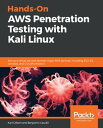 Hands-On AWS Penetration Testing with Kali Linux Set up a virtual lab and pentest major AWS services, including EC2, S3, Lambda, and CloudFormation【電子書籍】[ Karl Gilbert ] 楽天Kobo電子書籍ストア | <p><strong>Identify tools and techniques to secure and perform a penetration test on an AWS infrastructure using Kali Linux</strong></p> <h4>Key Features</h4> <ul> <li>Efficiently perform penetration testing techniques on your public cloud instances</li> <li>Learn not only to cover loopholes but also to automate security monitoring and alerting within your cloud-based deployment pipelines</li> <li>A step-by-step guide that will help you leverage the most widely used security platform to secure your AWS Cloud environment</li> </ul> <h4>Book Description</h4> <p>The cloud is taking over the IT industry. Any organization housing a large amount of data or a large infrastructure has started moving cloud-ward ー and AWS rules the roost when it comes to cloud service providers, with its closest competitor having less than half of its market share. This highlights the importance of security on the cloud, especially on AWS. While a lot has been said (and written) about how cloud environments can be secured, performing external security assessments in the form of pentests on AWS is still seen as a dark art.</p> <p>This book aims to help pentesters as well as seasoned system administrators with a hands-on approach to pentesting the various cloud services provided by Amazon through AWS using Kali Linux. To make things easier for novice pentesters, the book focuses on building a practice lab and refining penetration testing with Kali Linux on the cloud. This is helpful not only for beginners but also for pentesters who want to set up a pentesting environment in their private cloud, using Kali Linux to perform a white-box assessment of their own cloud resources. Besides this, there is a lot of in-depth coverage of the large variety of AWS services that are often overlooked during a pentest ー from serverless infrastructure to automated deployment pipelines.</p> <p>By the end of this book, you will be able to identify possible vulnerable areas efficiently and secure your AWS cloud environment.</p> <h4>What you will learn</h4> <ul> <li>Familiarize yourself with and pentest the most common external-facing AWS services</li> <li>Audit your own infrastructure and identify flaws, weaknesses, and loopholes</li> <li>Demonstrate the process of lateral and vertical movement through a partially compromised AWS account</li> <li>Maintain stealth and persistence within a compromised AWS account</li> <li>Master a hands-on approach to pentesting</li> <li>Discover a number of automated tools to ease the process of continuously assessing and improving the security stance of an AWS infrastructure</li> </ul> <h4>Who this book is for</h4> <p>If you are a security analyst or a penetration tester and are interested in exploiting Cloud environments to reveal vulnerable areas and secure them, then this book is for you.</p> <p>A basic understanding of penetration testing, cloud computing, and its security concepts is mandatory.</p>画面が切り替わりますので、しばらくお待ち下さい。 ※ご購入は、楽天kobo商品ページからお願いします。※切り替わらない場合は、こちら をクリックして下さい。 ※このページからは注文できません。 | 3,858円 |
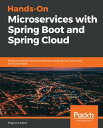 Hands-On Microservices with Spring Boot and Spring Cloud Build and deploy Java microservices using Spring Cloud, Istio, and Kubernetes【電子書籍】[ Magnus Larsson ] 楽天Kobo電子書籍ストア | <p><b>Apply microservices patterns to build resilient and scalable distributed systems</b></p><h2>Key Features</h2><ul><li>Understand the challenges of building large-scale microservice landscapes</li><li>Build cloud-native production-ready microservices with this comprehensive guide</li><li>Discover how to get the best out of Spring Cloud, Kubernetes, and Istio when used together</li></ul><h2>Book Description</h2>Microservices architecture allows developers to build and maintain applications with ease, and enterprises are rapidly adopting it to build software using Spring Boot as their default framework. With this book, you’ll learn how to efficiently build and deploy microservices using Spring Boot. This microservices book will take you through tried and tested approaches to building distributed systems and implementing microservices architecture in your organization. Starting with a set of simple cooperating microservices developed using Spring Boot, you’ll learn how you can add functionalities such as persistence, make your microservices reactive, and describe their APIs using Swagger/OpenAPI. As you advance, you’ll understand how to add different services from Spring Cloud to your microservice system. The book also demonstrates how to deploy your microservices using Kubernetes and manage them with Istio for improved security and traffic management. Finally, you’ll explore centralized log management using the EFK stack and monitor microservices using Prometheus and Grafana. By the end of this book, you’ll be able to build microservices that are scalable and robust using Spring Boot and Spring Cloud.<h2>What you will learn</h2><ul><li>Build reactive microservices using Spring Boot</li><li>Develop resilient and scalable microservices using Spring Cloud</li><li>Use OAuth 2.0/OIDC and Spring Security to protect public APIs</li><li>Implement Docker to bridge the gap between development, testing, and production</li><li>Deploy and manage microservices using Kubernetes</li><li>Apply Istio for improved security, observability, and traffic management</li></ul><h2>Who this book is for</h2><p>This book is for Java and Spring developers and architects who want to learn how to break up their existing monoliths into microservices and deploy them either on-premises or in the cloud using Kubernetes as a container orchestrator and Istio as a service Mesh. No familiarity with microservices architecture is required to get started with this book.</p>画面が切り替わりますので、しばらくお待ち下さい。 ※ご購入は、楽天kobo商品ページからお願いします。※切り替わらない場合は、こちら をクリックして下さい。 ※このページからは注文できません。 | 5,166円 |
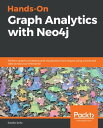 Hands-On Graph Analytics with Neo4j Perform graph processing and visualization techniques using connected data across your enterprise【電子書籍】[ Estelle Scifo ] 楽天Kobo電子書籍ストア | <p><strong>Discover how to use Neo4j to identify relationships within complex and large graph datasets using graph modeling, graph algorithms, and machine learning</strong></p> <h4>Key Features</h4> <ul> <li>Get up and running with graph analytics with the help of real-world examples</li> <li>Explore various use cases such as fraud detection, graph-based search, and recommendation systems</li> <li>Get to grips with the Graph Data Science library with the help of examples, and use Neo4j in the cloud for effective application scaling</li> </ul> <h4>Book Description</h4> <p>Neo4j is a graph database that includes plugins to run complex graph algorithms.</p> <p>The book starts with an introduction to the basics of graph analytics, the Cypher query language, and graph architecture components, and helps you to understand why enterprises have started to adopt graph analytics within their organizations. You'll find out how to implement Neo4j algorithms and techniques and explore various graph analytics methods to reveal complex relationships in your data. You'll be able to implement graph analytics catering to different domains such as fraud detection, graph-based search, recommendation systems, social networking, and data management. You'll also learn how to store data in graph databases and extract valuable insights from it. As you become well-versed with the techniques, you'll discover graph machine learning in order to address simple to complex challenges using Neo4j. You will also understand how to use graph data in a machine learning model in order to make predictions based on your data. Finally, you'll get to grips with structuring a web application for production using Neo4j.</p> <p>By the end of this book, you'll not only be able to harness the power of graphs to handle a broad range of problem areas, but you'll also have learned how to use Neo4j efficiently to identify complex relationships in your data.</p> <h4>What you will learn</h4> <ul> <li>Become well-versed with Neo4j graph database building blocks, nodes, and relationships</li> <li>Discover how to create, update, and delete nodes and relationships using Cypher querying</li> <li>Use graphs to improve web search and recommendations</li> <li>Understand graph algorithms such as pathfinding, spatial search, centrality, and community detection</li> <li>Find out different steps to integrate graphs in a normal machine learning pipeline</li> <li>Formulate a link prediction problem in the context of machine learning</li> <li>Implement graph embedding algorithms such as DeepWalk, and use them in Neo4j graphs</li> </ul> <h4>Who this book is for</h4> <p>This book is for data analysts, business analysts, graph analysts, and database developers looking to store and process graph data to reveal key data insights. This book will also appeal to data scientists who want to build intelligent graph applications catering to different domains. Some experience with Neo4j is required.</p>画面が切り替わりますので、しばらくお待ち下さい。 ※ご購入は、楽天kobo商品ページからお願いします。※切り替わらない場合は、こちら をクリックして下さい。 ※このページからは注文できません。 | 3,858円 |
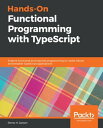 Hands-On Functional Programming with TypeScript Explore functional and reactive programming to create robust and testable TypeScript applications【電子書籍】[ Remo H. Jansen ] 楽天Kobo電子書籍ストア | <p><strong>Discover the power of functional programming, lazy evaluation, monads, concurrency, and immutability to create succinct and expressive implementations</strong></p> <h4>Key Features</h4> <ul> <li>Get a solid understanding of how to apply functional programming concepts in TypeScript</li> <li>Explore TypeScript runtime features such as event loop, closures, and Prototypes</li> <li>Gain deeper knowledge on the pros and cons of TypeScript</li> </ul> <h4>Book Description</h4> <p>Functional programming is a powerful programming paradigm that can help you to write better code. However, learning functional programming can be complicated, and the existing literature is often too complex for beginners. This book is an approachable introduction to functional programming and reactive programming with TypeScript for readers without previous experience in functional programming with JavaScript, TypeScript , or any other programming language.</p> <p>The book will help you understand the pros, cons, and core principles of functional programming in TypeScript. It will explain higher order functions, referential transparency, functional composition, and monads with the help of effective code examples. Using TypeScript as a functional programming language, you'll also be able to brush up on your knowledge of applying functional programming techniques, including currying, laziness, and immutability, to real-world scenarios.</p> <p>By the end of this book, you will be confident when it comes to using core functional and reactive programming techniques to help you build effective applications with TypeScript.</p> <h4>What you will learn</h4> <ul> <li>Understand the pros and cons of functional programming</li> <li>Delve into the principles, patterns, and best practices of functional and reactive programming</li> <li>Use lazy evaluation to improve the performance of applications</li> <li>Explore functional optics with Ramda</li> <li>Gain insights into category theory functional data structures such as Functors and Monads</li> <li>Use functions as values, so that they can be passed as arguments to other functions</li> </ul> <h4>Who this book is for</h4> <p>This book is designed for readers with no prior experience of functional programming with JavaScript, TypeScript or any other programming language. Some familiarity with TypeScript and web development is a must to grasp the concepts in the book easily.</p>画面が切り替わりますので、しばらくお待ち下さい。 ※ご購入は、楽天kobo商品ページからお願いします。※切り替わらない場合は、こちら をクリックして下さい。 ※このページからは注文できません。 | 2,950円 |
 Hands-On Julia Programming: An Authoritative Guide to the Production-Ready Systems in Julia (English Edition)【電子書籍】[ Sambit Kumar Dash ] 楽天Kobo電子書籍ストア | <p>Build production-ready machine learning and NLP systems using functional programming, development platforms, and cloud deployment.</p> <p>KEY FEATURES</p> <p>● In-depth explanation and code samples highlighting the features of the Julia language.</p> <p>● Extensive coverage of the Julia development ecosystem, package management, DevOps environment integration, and performance management tools.</p> <p>● Exposure to the most important Julia packages that aid in Data and Text Analytics and Deep Learning.</p> <p>DESCRIPTION</p> <p>The Julia Programming language enables data scientists and programmers to create prototypes without sacrificing performance. Nonetheless, skeptics question its readiness for production deployments as a new platform with a 1.0 release in 2018. This book removes these doubts and offers a comprehensive glimpse at the language's use throughout developing and deploying production-ready applications.</p> <p>The first part of the book teaches experienced programmers and scientists about the Julia language features in great detail. The second part consists of gaining hands-on experience with the development environment, debugging, programming guidelines, package management, and cloud deployment strategies. In the final section, readers are introduced to a variety of third-party packages available in the Julia ecosystem for Data Processing, Text Analytics, and developing Deep Learning models.</p> <p>This book provides an extensive overview of the programming language and broadens understanding of the Julia ecosystem. As a result, it assists programmers, scientists, and information architects in selecting Julia for their next production deployments.</p> <p>WHAT YOU WILL LEARN</p> <p>● Get to know the complete fundamentals of Julia programming.</p> <p>● Explore Julia development frameworks and how to work with them.</p> <p>● Dig deeper into the concepts and applications of functional programming.</p> <p>● Uncover the Julia infrastructure for development, testing, and deployment.</p> <p>● Learn to practice Julia libraries and the Julia package ecosystem.</p> <p>● Processing Data, Deep Learning, and Natural Language Processing with Julia.</p> <p>WHO THIS BOOK IS FOR</p> <p>This book is for Data Scientists and application developers who want to learn about Julia application development. No prior Julia knowledge is required but knowing the basics of programming helps understand the objectives of this book.</p> <p>AUTHOR BIO</p> <p>Sambit Kumar Dash is an accomplished business manager who focuses on bringing technology product ideas to reality. He has over 20 years of experience in product and business management, architecture, and research and development. He has conceived and developed a PDF reader library in the Julia language.</p>画面が切り替わりますので、しばらくお待ち下さい。 ※ご購入は、楽天kobo商品ページからお願いします。※切り替わらない場合は、こちら をクリックして下さい。 ※このページからは注文できません。 | 2,300円 |
 Hands-on Azure Boards Configuring and Customizing Process Workflows in Azure DevOps Services【電子書籍】[ Chaminda Chandrasekara ] 楽天Kobo電子書籍ストア | <p>Understand and explore the features and management of Azure Boards with this book, which also covers Azure Boards configuration and advanced administration. This book starts by setting up projects with Azure DevOps and gives an overview of Azure Boards and its features. You will then learn to set up team projects and how to effectively use Azure Boards to plan and execute work.</p> <p><em>Hands-on Azure Boards</em> explains customizations, where you will understand the available options to track your work considering different scenarios. Next, you will learn visualizing with queries, charts, and dashboards along with reporting of Azure Boards. The author gives you hands-on lessons to set up Azure Boards and shows you how to handle multiple modules that are taken care of by different teams.</p> <p>You will also explore the security options in Azure Boards as well as a detailed demonstration of working with the REST API and CLI. Finally,you will work with useful extensions for Azure Boards and see how to use them more effectively and efficiently. After reading this book, you will be able to work with the Azure Boards capabilities available in Azure DevOps on-premise server and services to improve your software delivery process.</p> <p><strong>What You Will Learn</strong></p> <ul> <li>Plan and manage work with Azure Boards</li> <li>Use the REST API and command line interface with Azure Boards</li> <li>Extend Azure Boards with useful extensions to enhance its capabilities</li> <li>Customize Azure Boards to adapt it to your process</li> <li>Report and visualize work progress with Azure Boards</li> </ul> <p><strong>Who This Book Is For</strong></p> <p>Anyone working in Azure DevOps developing applications targeting any platform using any language.</p>画面が切り替わりますので、しばらくお待ち下さい。 ※ご購入は、楽天kobo商品ページからお願いします。※切り替わらない場合は、こちら をクリックして下さい。 ※このページからは注文できません。 | 9,116円 |
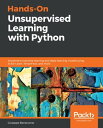 Hands-On Unsupervised Learning with Python Implement machine learning and deep learning models using Scikit-Learn, TensorFlow, and more【電子書籍】[ Giuseppe Bonaccorso ] 楽天Kobo電子書籍ストア | <p><strong>Discover the skill-sets required to implement various approaches to Machine Learning with Python</strong></p> <h4>Key Features</h4> <ul> <li>Explore unsupervised learning with clustering, autoencoders, restricted Boltzmann machines, and more</li> <li>Build your own neural network models using modern Python libraries</li> <li>Practical examples show you how to implement different machine learning and deep learning techniques</li> </ul> <h4>Book Description</h4> <p>Unsupervised learning is about making use of raw, untagged data and applying learning algorithms to it to help a machine predict its outcome. With this book, you will explore the concept of unsupervised learning to cluster large sets of data and analyze them repeatedly until the desired outcome is found using Python.</p> <p>This book starts with the key differences between supervised, unsupervised, and semi-supervised learning. You will be introduced to the best-used libraries and frameworks from the Python ecosystem and address unsupervised learning in both the machine learning and deep learning domains. You will explore various algorithms, techniques that are used to implement unsupervised learning in real-world use cases. You will learn a variety of unsupervised learning approaches, including randomized optimization, clustering, feature selection and transformation, and information theory. You will get hands-on experience with how neural networks can be employed in unsupervised scenarios. You will also explore the steps involved in building and training a GAN in order to process images.</p> <p>By the end of this book, you will have learned the art of unsupervised learning for different real-world challenges.</p> <h4>What you will learn</h4> <ul> <li>Use cluster algorithms to identify and optimize natural groups of data</li> <li>Explore advanced non-linear and hierarchical clustering in action</li> <li>Soft label assignments for fuzzy c-means and Gaussian mixture models</li> <li>Detect anomalies through density estimation</li> <li>Perform principal component analysis using neural network models</li> <li>Create unsupervised models using GANs</li> </ul> <h4>Who this book is for</h4> <p>This book is intended for statisticians, data scientists, machine learning developers, and deep learning practitioners who want to build smart applications by implementing key building block unsupervised learning, and master all the new techniques and algorithms offered in machine learning and deep learning using real-world examples. Some prior knowledge of machine learning concepts and statistics is desirable.</p>画面が切り替わりますので、しばらくお待ち下さい。 ※ご購入は、楽天kobo商品ページからお願いします。※切り替わらない場合は、こちら をクリックして下さい。 ※このページからは注文できません。 | 3,858円 |
 Arduino Nano Every A Hands-On Guide【電子書籍】[ Agus Kurniawan ] 楽天Kobo電子書籍ストア | <p>This book helps you to get started with Arduino Nano Every development with step-by-step approach and project samples. The following is a list of highlight topics in this book:</p> <ul> <li>Preparing Development Environment</li> <li>Setting Up Arduino Nano Every</li> <li>Writing and Reading Digital Data</li> <li>Serial Communication (UART)</li> <li>PWM and Analog Input</li> <li>Working with I2C</li> <li>Working with SPI</li> <li>Accessing EEPROM</li> <li>Working with DHT Module</li> <li>Working with GPS Module</li> </ul>画面が切り替わりますので、しばらくお待ち下さい。 ※ご購入は、楽天kobo商品ページからお願いします。※切り替わらない場合は、こちら をクリックして下さい。 ※このページからは注文できません。 | 377円 |
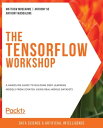 The TensorFlow Workshop A hands-on guide to building deep learning models from scratch using real-world datasets【電子書籍】[ Anthony Maddalone ] 楽天Kobo電子書籍ストア | <p><strong>Get started with TensorFlow fundamentals to build and train deep learning models with real-world data, practical exercises, and challenging activities</strong></p> <h4>Key Features</h4> <ul> <li>Understand the fundamentals of tensors, neural networks, and deep learning</li> <li>Discover how to implement and fine-tune deep learning models for real-world datasets</li> <li>Build your experience and confidence with hands-on exercises and activities</li> </ul> <h4>Book Description</h4> <p>Getting to grips with tensors, deep learning, and neural networks can be intimidating and confusing for anyone, no matter their experience level. The breadth of information out there, often written at a very high level and aimed at advanced practitioners, can make getting started even more challenging.</p> <p>If this sounds familiar to you, The TensorFlow Workshop is here to help. Combining clear explanations, realistic examples, and plenty of hands-on practice, it'll quickly get you up and running.</p> <p>You'll start off with the basics ? learning how to load data into TensorFlow, perform tensor operations, and utilize common optimizers and activation functions. As you progress, you'll experiment with different TensorFlow development tools, including TensorBoard, TensorFlow Hub, and Google Colab, before moving on to solve regression and classification problems with sequential models.</p> <p>Building on this solid foundation, you'll learn how to tune models and work with different types of neural network, getting hands-on with real-world deep learning applications such as text encoding, temperature forecasting, image augmentation, and audio processing.</p> <p>By the end of this deep learning book, you'll have the skills, knowledge, and confidence to tackle your own ambitious deep learning projects with TensorFlow.</p> <h4>What you will learn</h4> <ul> <li>Get to grips with TensorFlow's mathematical operations</li> <li>Pre-process a wide variety of tabular, sequential, and image data</li> <li>Understand the purpose and usage of different deep learning layers</li> <li>Perform hyperparameter-tuning to prevent overfitting of training data</li> <li>Use pre-trained models to speed up the development of learning models</li> <li>Generate new data based on existing patterns using generative models</li> </ul> <h4>Who this book is for</h4> <p>This TensorFlow book is for anyone who wants to develop their understanding of deep learning and get started building neural networks with TensorFlow. Basic knowledge of Python programming and its libraries, as well as a general understanding of the fundamentals of data science and machine learning, will help you grasp the topics covered in this book more easily.</p>画面が切り替わりますので、しばらくお待ち下さい。 ※ご購入は、楽天kobo商品ページからお願いします。※切り替わらない場合は、こちら をクリックして下さい。 ※このページからは注文できません。 | 3,858円 |
 Rust Web Programming A hands-on guide to developing fast and secure web apps with the Rust programming language【電子書籍】[ Maxwell Flitton ] 楽天Kobo電子書籍ストア | <p><strong>Adopt the Rust programming language by learning how to build fully functional web applications and services and address challenges relating to safety and performance</strong></p> <h4>Key Features</h4> <ul> <li>Build scalable web applications in Rust using popular frameworks such as Actix, Rocket, and Warp</li> <li>Create front-end components that can be injected into multiple views</li> <li>Develop data models in Rust to interact with the database</li> </ul> <h4>Book Description</h4> <p>Are safety and high performance a big concern for you while developing web applications?</p> <p>While most programming languages have a safety or speed trade-off, Rust provides memory safety without using a garbage collector. This means that with its low memory footprint, you can build high-performance and secure web apps with relative ease.</p> <p>This book will take you through each stage of the web development process, showing you how to combine Rust and modern web development principles to build supercharged web apps.</p> <p>You'll start with an introduction to Rust and understand how to avoid common pitfalls when migrating from traditional dynamic programming languages. The book will show you how to structure Rust code for a project that spans multiple pages and modules. Next, you'll explore the Actix Web framework and get a basic web server up and running. As you advance, you'll learn how to process JSON requests and display data from the web app via HTML, CSS, and JavaScript. You'll also be able to persist data and create RESTful services in Rust. Later, you'll build an automated deployment process for the app on an AWS EC2 instance and Docker Hub. Finally, you'll play around with some popular web frameworks in Rust and compare them.</p> <p>By the end of this Rust book, you'll be able to confidently create scalable and fast web applications with Rust.</p> <h4>What you will learn</h4> <ul> <li>Structure scalable web apps in Rust in Rocket, Actix Web, and Warp</li> <li>Apply data persistence for your web apps using PostgreSQL</li> <li>Build login, JWT, and config modules for your web apps</li> <li>Serve HTML, CSS, and JavaScript from the Actix Web server</li> <li>Build unit tests and functional API tests in Postman and Newman</li> <li>Deploy the Rust app with NGINX and Docker onto an AWS EC2 instance</li> </ul> <h4>Who this book is for</h4> <p>This book on web programming with Rust is for web developers who have programmed in traditional languages such as Python, Ruby, JavaScript, and Java and are looking to develop high-performance web applications with Rust. Although no prior experience with Rust is necessary, a solid understanding of web development principles and basic knowledge of HTML, CSS, and JavaScript are required if you want to get the most out of this book.</p>画面が切り替わりますので、しばらくお待ち下さい。 ※ご購入は、楽天kobo商品ページからお願いします。※切り替わらない場合は、こちら をクリックして下さい。 ※このページからは注文できません。 | 3,290円 |
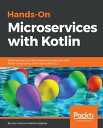 Hands-On Microservices with Kotlin Build reactive and cloud-native microservices with Kotlin using Spring 5 and Spring Boot 2.0【電子書籍】[ Juan Antonio Medina Iglesias ] 楽天Kobo電子書籍ストア | <p>Build smart, efficient, and fast enterprise-grade web implementation of the microservices architecture that can be easily scaled. About This Book ? Write easy-to-maintain lean and clean code with Kotlin for developing better microservices ? Scale your Microserivces in your own cloud with Docker and Docker Swarm ? Explore Spring 5 functional reactive web programming with Spring WebFlux Who This Book Is For If you are a Kotlin developer with a basic knowledge of microservice architectures and now want to effectively implement these services on enterprise-level web applications, then this book is for you What You Will Learn ? Understand microservice architectures and principles ? Build microservices in Kotlin using Spring Boot 2.0 and Spring Framework 5.0 ? Create reactive microservices that perform non-blocking operations with Spring WebFlux ? Use Spring Data to get data reactively from MongoDB ? Test effectively with JUnit and Kotlin ? Create cloud-native microservices with Spring Cloud ? Build and publish Docker images of your microservices ? Scaling microservices with Docker Swarm ? Monitor microservices with JMX ? Deploy microservices in OpenShift Online In Detail With Google's inclusion of first-class support for Kotlin in their Android ecosystem, Kotlin's future as a mainstream language is assured. Microservices help design scalable, easy-to-maintain web applications; Kotlin allows us to take advantage of modern idioms to simplify our development and create high-quality services. With 100% interoperability with the JVM, Kotlin makes working with existing Java code easier. Well-known Java systems such as Spring, Jackson, and Reactor have included Kotlin modules to exploit its language features. This book guides the reader in designing and implementing services, and producing production-ready, testable, lean code that's shorter and simpler than a traditional Java implementation. Reap the benefits of using the reactive paradigm and take advantage of non-blocking techniques to take your services to the next level in terms of industry standards. You will consume NoSQL databases reactively to allow you to create high-throughput microservices. Create cloud-native microservices that can run on a wide range of cloud providers, and monitor them. You will create Docker containers for your microservices and scale them. Finally, you will deploy your microservices in OpenShift Online. Style and approach This book guides the reader in designing and implementing services, achieving production- ready, testable, easy-to-maintain, lean code that's shorter and simpler than a traditional Java implementation.</p>画面が切り替わりますので、しばらくお待ち下さい。 ※ご購入は、楽天kobo商品ページからお願いします。※切り替わらない場合は、こちら をクリックして下さい。 ※このページからは注文できません。 | 4,540円 |
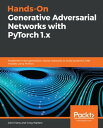 Hands-On Generative Adversarial Networks with PyTorch 1.x Implement next-generation neural networks to build powerful GAN models using Python【電子書籍】[ John Hany ] 楽天Kobo電子書籍ストア | <p><strong>Apply deep learning techniques and neural network methodologies to build, train, and optimize generative network models</strong></p> <h4>Key Features</h4> <ul> <li>Implement GAN architectures to generate images, text, audio, 3D models, and more</li> <li>Understand how GANs work and become an active contributor in the open source community</li> <li>Learn how to generate photo-realistic images based on text descriptions</li> </ul> <h4>Book Description</h4> <p>With continuously evolving research and development, Generative Adversarial Networks (GANs) are the next big thing in the field of deep learning. This book highlights the key improvements in GANs over generative models and guides in making the best out of GANs with the help of hands-on examples.</p> <p>This book starts by taking you through the core concepts necessary to understand how each component of a GAN model works. You'll build your first GAN model to understand how generator and discriminator networks function. As you advance, you'll delve into a range of examples and datasets to build a variety of GAN networks using PyTorch functionalities and services, and become well-versed with architectures, training strategies, and evaluation methods for image generation, translation, and restoration. You'll even learn how to apply GAN models to solve problems in areas such as computer vision, multimedia, 3D models, and natural language processing (NLP). The book covers how to overcome the challenges faced while building generative models from scratch. Finally, you'll also discover how to train your GAN models to generate adversarial examples to attack other CNN and GAN models.</p> <p>By the end of this book, you will have learned how to build, train, and optimize next-generation GAN models and use them to solve a variety of real-world problems.</p> <h4>What you will learn</h4> <ul> <li>Implement PyTorch's latest features to ensure efficient model designing</li> <li>Get to grips with the working mechanisms of GAN models</li> <li>Perform style transfer between unpaired image collections with CycleGAN</li> <li>Build and train 3D-GANs to generate a point cloud of 3D objects</li> <li>Create a range of GAN models to perform various image synthesis operations</li> <li>Use SEGAN to suppress noise and improve the quality of speech audio</li> </ul> <h4>Who this book is for</h4> <p>This GAN book is for machine learning practitioners and deep learning researchers looking to get hands-on guidance in implementing GAN models using PyTorch. You'll become familiar with state-of-the-art GAN architectures with the help of real-world examples. Working knowledge of Python programming language is necessary to grasp the concepts covered in this book.</p>画面が切り替わりますので、しばらくお待ち下さい。 ※ご購入は、楽天kobo商品ページからお願いします。※切り替わらない場合は、こちら をクリックして下さい。 ※このページからは注文できません。 | 3,290円 |
 100 Easy STEAM Activities Awesome Hands-On Projects for Aspiring Artists and Engineers【電子書籍】[ Andrea Scalzo Yi ] 楽天Kobo電子書籍ストア | <p><strong>Exciting Activities for Young Artists, Scientists and Engineers</strong></p> <p>Spark your curiosity with these fun games and creative projects to learn early concepts in Science, Technology, Engineering, Art and Math. These incredible activities from Andrea Scalzo Yi, creator of Raising Dragons, make learning such a blast, you’ll forget you’re doing it!</p> <p>Feeling bored on a rainy day? Now you can pick a project, gather your supplies and let the magic happen. Try far-out science experiments like making Shaving Cream Rain Clouds or Lava Lamps. Make math-time snack-time with delicious Cream-Filled Cookie Fractions. Unlock boundless creativity with art projects like Marbled Paper or Monster Bugs. With seasonal activities like the Pool Noodle Obstacle Course and Erupting Pumpkins, there are games to love year-round.</p> <p>Have fun learning early ideas in chemistry, physics, computing, color-mixing and so much more, all while problem-solving and working together with friends. With projects that use common household items and require little adult supervision, <em>100 Easy STEAM Activities</em> is the ultimate resource for an amazing, creative day of learning.</p>画面が切り替わりますので、しばらくお待ち下さい。 ※ご購入は、楽天kobo商品ページからお願いします。※切り替わらない場合は、こちら をクリックして下さい。 ※このページからは注文できません。 | 1,494円 |
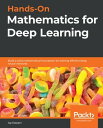 Hands-On Mathematics for Deep Learning Build a solid mathematical foundation for training efficient deep neural networks【電子書籍】[ Jay Dawani ] 楽天Kobo電子書籍ストア | <p><strong>A comprehensive guide to getting well-versed with the mathematical techniques for building modern deep learning architectures</strong></p> <h4>Key Features</h4> <ul> <li>Understand linear algebra, calculus, gradient algorithms, and other concepts essential for training deep neural networks</li> <li>Learn the mathematical concepts needed to understand how deep learning models function</li> <li>Use deep learning for solving problems related to vision, image, text, and sequence applications</li> </ul> <h4>Book Description</h4> <p>Most programmers and data scientists struggle with mathematics, having either overlooked or forgotten core mathematical concepts. This book uses Python libraries to help you understand the math required to build deep learning (DL) models.</p> <p>You'll begin by learning about core mathematical and modern computational techniques used to design and implement DL algorithms. This book will cover essential topics, such as linear algebra, eigenvalues and eigenvectors, the singular value decomposition concept, and gradient algorithms, to help you understand how to train deep neural networks. Later chapters focus on important neural networks, such as the linear neural network and multilayer perceptrons, with a primary focus on helping you learn how each model works. As you advance, you will delve into the math used for regularization, multi-layered DL, forward propagation, optimization, and backpropagation techniques to understand what it takes to build full-fledged DL models. Finally, you'll explore CNN, recurrent neural network (RNN), and GAN models and their application.</p> <p>By the end of this book, you'll have built a strong foundation in neural networks and DL mathematical concepts, which will help you to confidently research and build custom models in DL.</p> <h4>What you will learn</h4> <ul> <li>Understand the key mathematical concepts for building neural network models</li> <li>Discover core multivariable calculus concepts</li> <li>Improve the performance of deep learning models using optimization techniques</li> <li>Cover optimization algorithms, from basic stochastic gradient descent (SGD) to the advanced Adam optimizer</li> <li>Understand computational graphs and their importance in DL</li> <li>Explore the backpropagation algorithm to reduce output error</li> <li>Cover DL algorithms such as convolutional neural networks (CNNs), sequence models, and generative adversarial networks (GANs)</li> </ul> <h4>Who this book is for</h4> <p>This book is for data scientists, machine learning developers, aspiring deep learning developers, or anyone who wants to understand the foundation of deep learning by learning the math behind it. Working knowledge of the Python programming language and machine learning basics is required.</p>画面が切り替わりますので、しばらくお待ち下さい。 ※ご購入は、楽天kobo商品ページからお願いします。※切り替わらない場合は、こちら をクリックして下さい。 ※このページからは注文できません。 | 3,290円 |
 Practical Julia A Hands-On Introduction for Scientific Minds【電子書籍】[ Lee Phillips ] 楽天Kobo電子書籍ストア | <p><strong>Learn to use Julia as a tool for research, and solve problems of genuine interestーlike modeling the course of a pandemicーin this practical, hands-on introduction to the language.</strong></p> <p>The Julia programming language is acclaimed in scientific circles for its unparalleled ease, interactivity, and speed. <em>Practical Julia</em> is a comprehensive introduction to the language, making it accessible even if you’re new to programming.</p> <p>Dive in with a thorough guide to Julia’s syntax, data types, and best practices, then transition to craft solutions for challenges in physics, statistics, biology, mathematics, scientific machine learning, and more. Whether you’re solving computational problems, visualizing data, writing simulations, or developing specialized tools, <em>Practical Julia</em> will show you how.</p> <p>As you work through the book, you’ll:</p> <p>? Use comprehensions and generators, higher-level functions, array initialization and manipulation, and perform operations on Unicode text<br /> ? Create new syntax and generate code with metaprogramming and macros, and control the error system to manipulate program execution<br /> ? Visualize everything from mathematical constructs and experimental designs to algorithm flowcharts<br /> ? Elevate performance using Julia’s unique type system with multiple dispatch<br /> ? Delve into scientific packages tailored for diverse fields like fluid dynamics, agent-based modeling, and image processing</p> <p>Whether your interest is in scientific research, statistics, mathematics, or just the fun of programming with Julia, <em>Practical Julia</em> will have you writing high-performance code that can do real work in no time.</p> <p>Online Resources: Ready-to-run code samples, illustrations, and supplemental animations available at <em>julia.lee-phillips.org</em>.</p>画面が切り替わりますので、しばらくお待ち下さい。 ※ご購入は、楽天kobo商品ページからお願いします。※切り替わらない場合は、こちら をクリックして下さい。 ※このページからは注文できません。 | 5,127円 |
 PyTorch Deep Learning Hands-On Build CNNs, RNNs, GANs, reinforcement learning, and more, quickly and easily【電子書籍】[ Sherin Thomas ] 楽天Kobo電子書籍ストア | <p><strong>Hands-on projects cover all the key deep learning methods built step-by-step in PyTorch</strong></p> <h4>Key Features</h4> <ul> <li>Internals and principles of PyTorch</li> <li>Implement key deep learning methods in PyTorch: CNNs, GANs, RNNs, reinforcement learning, and more</li> <li>Build deep learning workflows and take deep learning models from prototyping to production</li> </ul> <h4>Book Description</h4> <p>PyTorch Deep Learning Hands-On is a book for engineers who want a fast-paced guide to doing deep learning work with Pytorch. It is not an academic textbook and does not try to teach deep learning principles. The book will help you most if you want to get your hands dirty and put PyTorch to work quickly.</p> <p>PyTorch Deep Learning Hands-On shows how to implement the major deep learning architectures in PyTorch. It covers neural networks, computer vision, CNNs, natural language processing (RNN), GANs, and reinforcement learning. You will also build deep learning workflows with the PyTorch framework, migrate models built in Python to highly efficient TorchScript, and deploy to production using the most sophisticated available tools.</p> <p>Each chapter focuses on a different area of deep learning. Chapters start with a refresher on how the model works, before sharing the code you need to implement them in PyTorch.</p> <p>This book is ideal if you want to rapidly add PyTorch to your deep learning toolset.</p> <h4>What you will learn</h4> <p>Use PyTorch to build:</p> <ul> <li>Simple Neural Networks ? build neural networks the PyTorch way, with high-level functions, optimizers, and more</li> <li>Convolutional Neural Networks ? create advanced computer vision systems</li> <li>Recurrent Neural Networks ? work with sequential data such as natural language and audio</li> <li>Generative Adversarial Networks ? create new content with models including SimpleGAN and CycleGAN</li> <li>Reinforcement Learning ? develop systems that can solve complex problems such as driving or game playing</li> <li>Deep Learning workflows ? move effectively from ideation to production with proper deep learning workflow using PyTorch and its utility packages</li> <li>Production-ready models ? package your models for high-performance production environments</li> </ul> <h4>Who this book is for</h4> <p>Machine learning engineers who want to put PyTorch to work.</p>画面が切り替わりますので、しばらくお待ち下さい。 ※ご購入は、楽天kobo商品ページからお願いします。※切り替わらない場合は、こちら をクリックして下さい。 ※このページからは注文できません。 | 3,290円 |